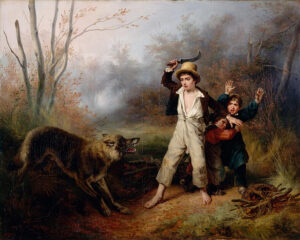Sequoyah, also known as George Gist (or Guess), was a blacksmith, dairyman, soldier, teacher, and linguist. Most famously, he became one of North America’s most brilliant polymaths and the creator of the written Cherokee language. Under his guidance, the Cherokee Nation saw social, political, and educational improvements. However, one day in 1842, he suddenly died from an illness. Over the years, there have been many rumors surrounding the location of his burial site.
Early life
The precise details of Sequoyah’s early life vary. Most sources state that Sequoyah was born near Knoxville, Tennessee a few years before the American Revolution, to a Cherokee mother named Wut-teh and a white father.
His father might have been Nathaniel Gist, a companion of George Washington. Gist was a high-ranking soldier in several wars, including the French and Indian War and the American Revolution. However, other sources state that his father might have been an ordinary soldier, a thief, or no one in particular.
Nevertheless, Sequoyah grew up with his mother and proved himself extremely self-sufficient. He had skills in gardening, landscaping, smithery, and art.
Written language
After moving to Alabama in the early 1800s, he had the idea of creating a written Cherokee language. Listening to Cherokee conversations closely, he assigned symbols and letters to go with the sounds. Sequoyah worked on this groundbreaking system for six years, creating an alphabet/syllabary of 86 letters. He hoped that his linguistic achievement would assist with literacy rates in the Cherokee territories.
Unfortunately, some of his contemporaries did not take kindly to this and accused him of sorcery. They could not fathom someone creating symbols of this nature, let alone a whole written language. Luckily, several people who knew him well vouched for his character.
Slowly but surely, his language gained acceptance and popularity. In 1825, it became the Cherokee Nation’s official language. The Nation gave him a medal for his contribution. The Cherokee thus became the first indigenous group in North America to have an official written language.

Sequoyah’s Cherokee script. Photo: Georgia Historical Society Rare Collection
Cherokee citizens started using the system to translate passages in the Bible. The language became ever more widespread. Written Cherokee officially appeared in print in 1828 with the launch of the bilingual Cherokee Phoenix newspaper. Soon enough, Cherokees used it in everyday situations like writing letters.
Sudden death
Sequoyah’s fame and success only increased when he visited Washington D.C. to represent the Cherokee Nation. The Cherokee had experienced hard times with the seizure of lands and general harassment from the surrounding white population.
Sequoyah’s passion for helping his disenfranchised people prompted him to venture to the nation’s capital to meet representatives of other indigenous tribes. He thought the best way to solve this crisis was to unite his fellow Cherokee, who were scattered throughout the country.
After his trip to D.C., he undertook an arduous journey across the southwestern U.S. to recruit these scattered Cherokee groups. His son and several others accompanied him. However, Sequoyah fell gravely ill and passed away shortly after in August 1843, at age 73. His wife and the public did not know he died until two years later.
Possible locations
In a letter written and signed by several expedition members, Sequoyah “departed this life in the town of San Fernando [in Coahuila, Mexico].” Supposedly, he lies in an unmarked grave near there. However, the exact location is unknown.
In 1903, the Washington Evening Star reported that two men named Erwin Fancher and J.M Hayes came forward to pinpoint the grave’s location in the Wichita Mountains in Oklahoma. Supposedly, Hayes and Fancher came across a cave in which they found a pipe that belonged to Sequoyah. Then they found the gravesite and a variety of old items including kitchen tools, a rifle, an ax, a hoe, and his medal.
On one side of the medal was the likeness of Thomas Jefferson with an engraving saying “TH. JEFFERSON PRESIDENT OF THE US. A.D 1801”. The medal’s other side had, “PEACE AND FRIENDSHIP”, along with an image of a pipe and tomahawk. However, the public and scholars did not accept this claim, because of the peculiar location.

Sequoyah stamp. Photo: Spatuletail/Shutterstock
In 1938, a brief search took place. Cherokee Nation leader J.B Milan scoured the Coahuila area and came across a potential gravesite. However, there were no follow-up investigations.
In 2001, a man named Charles Rogers stepped forward. Rogers, who happens to be Cherokee himself, claimed to have found the grave near a former north Mexican town called Sara Rosa, with the help of two locals.
A congressional report (Volume 147) stated that “Epic and Gloria Rodriguez of Mexico, whose ancestors helped Sequoyah and other Cherokees, directed the Rogers to the location. Rogers’ intent is not to return the remains of Sequoyah to Oklahoma, but to recognize his grave in order to preserve the richness of the Cherokee heritage.”
The takeaway
Sequoyah’s grave remains a mystery to this day. Oddly enough, there have not been any further attempts to find him. Several questions remain unanswered. Why didn’t his son bring his body home? It is odd that there was no clear grave marker so Cherokees can pay homage to their beloved polymath. Did his comrades even want him to be found?
It is likely that the long, arduous journey across the wilderness prevented his son from carrying his body and forced him to bury his father in an impromptu grave. Possibly, since Sequoyah was so dedicated to his people, he made it his dying wish for his grave to remain anonymous so people could focus on his legacy. He may have thought his death could finally unite the Cherokee.
Searches for Sequoyah eventually stopped when the Cherokee Nation expressed its desire to leave the matter be, out of respect. Fortunately, his work lived on. Today, many institutions honor his name.






